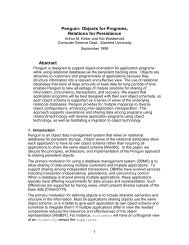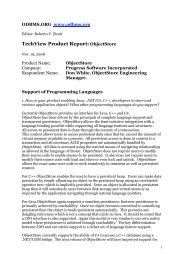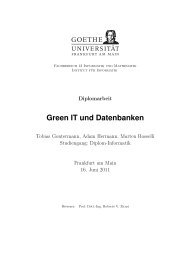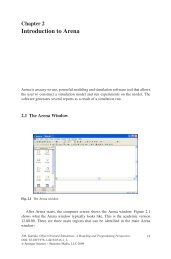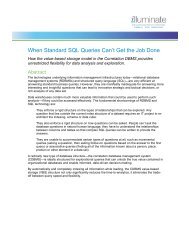Download Chapters 3-6 (.PDF) - ODBMS
Download Chapters 3-6 (.PDF) - ODBMS
Download Chapters 3-6 (.PDF) - ODBMS
You also want an ePaper? Increase the reach of your titles
YUMPU automatically turns print PDFs into web optimized ePapers that Google loves.
32 5. DISCUSSION—THE STRUCTURE OF SPECIFIC GRAPHS<br />
Layers<br />
Core<br />
Hanging nodes<br />
Figure 5.1: The Internet as a“Jellyfish:”The Internet AS-level graph can be thought of as a core,surrounded<br />
by concentric layers around the core. There are many one-degree nodes that hang off the core and each<br />
of the layers.<br />
bowtie is the Strongly Connected Component (SCC) of the graph: each node in the SCC has a directed<br />
path to any other node in the SCC.Then, there is the IN component: each node in the IN component<br />
has a directed path to all the nodes in the SCC. Similarly, there is an OUT component, where each<br />
node can be reached by directed paths from the SCC. Apart from these, there are webpages which<br />
can reach some pages in OUT and can be reached from pages in IN without going through the SCC;<br />
these are the TENDRILS. Occasionally, a tendril can connect nodes in IN and OUT; the tendril is<br />
called a TUBE in this case. The remainder of the webpages fall in disconnected components. A similar<br />
study focused on only the Chilean part of the Web graph found that the disconnected component<br />
is actually very large (nearly 50% of the graph size) [31].<br />
Dill et al. [93] extend this view of the Web by considering subgraphs of the WWW at different<br />
scales (Figure 5.2(b)). These subgraphs are groups of webpages sharing some common trait, such as<br />
content or geographical location. They have several remarkable findings:<br />
1. Recursive bowtie structure: Each of these subgraphs forms a bowtie of its own. Thus, the Web<br />
graph can be thought of as a hierarchy of bowties, each representing a specific subgraph.<br />
2. Ease of navigation: The SCC components of all these bowties are tightly connected together via<br />
the SCC of the whole Web graph. This provides a navigational backbone for the Web: starting<br />
from a webpage in one bowtie, we can click to its SCC, then go via the SCC of the entire Web<br />
to the destination bowtie.<br />
3. Resilience: The union of a random collection of subgraphs of the Web has a large SCC component,<br />
meaning that the SCCs of the individual subgraphs have strong connections to other<br />
SCCs. Thus, the Web graph is very resilient to node deletions and does not depend on the<br />
existence of large taxonomies such as yahoo.com; there are several alternate paths between<br />
nodes in the SCC.




